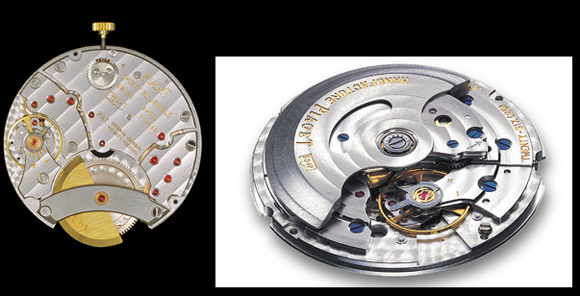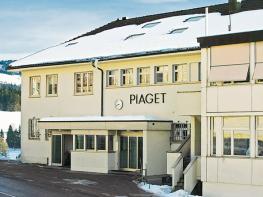The manufacture of ultra-flat movements is in itself one of the most elaborate and difficult in the realm of advanced calibre technologies. Piaget, renowned for the splendour and magnificence of its bejewelled watches and goldsmith’s art is also one of the most respected authorities in slender mechanical and quartz movements.
Geographically and technically split into two separate facilities – La Côte-aux-Fées, deep and high in the Swiss Jura, and Plan-les-Ouates in the vicinity of Geneva – the manufacturing process at Piaget maintains a profound use of ancient traditions with a revolutionary utilization of the most modern technologies, processes and materials, always in the search of the most beautiful and thinnest watches ever created.
The factory buildings at La Côte-aux-Fées (picture above) have their origin as the ancient Piaget family farm house, where in 1874 Georges Piaget founded the business to supply the most important watch companies with its elaborate and elegant movements as private label. The Piaget business grew accordingly and in the 1940s the third generation of Piaget owners decided under the aegis of Gérald and Valentin Piaget to sign watches under their own trade brand, Piaget.

The original facility at La Côte-aux-Fées houses time-honoured stamping presses from 1946 that are used to transform metal rods into actual raw components, whereas modern multi-axis CNC/ CAD tools along with spark erosion machines are used to perform tasks that will result in extremely tiny and precise elements that experienced watchmakers at traditional workbenches will finish and decorate manually in order to assemble the latest generation of Piaget movements.
Inspired by the great technical achievements of the 1960s such as the Calibre 9P (at the time the thinnest manual wound movement at only 2mm in height) and the Calibre 12P (the thinnest self-winding micro-rotor movement with a height of 2.3mm), Piaget currently boasts calibres such as the renowned 883, which is the thinnest manual wind chronograph movement with a height of 4.65mm, the ultra-flat mechanical hand wound integrated movement 900P with only 3.65mm and the thinnest automatic tourbillon, equipped with an integrated micro-rotor, Calibre 1270P with a height of only 5.5mm. At this level of movement architecture, tolerances are extremely tight, since some components have a thickness of just 0.02mm, which is much thinner than a human hair.

The incredible facility at Plan-les-Ouates, inaugurated in 2001 under the management of Piaget’s current CEO, Philippe Leopold-Metzger, is a great architectural demonstration of the commitment of the brand to the use of modern technology. These are the premises where Piaget smelts gold and platinum at its own foundry to create its watch cases and bracelets as well as the sophisticated pieces of jewellery that form a key part of the firm’s business. This is also the site where the movements are encased and decorated and where gem setting takes place. There is also a small and private Piaget Patrimony Museum with historical and iconic pieces of the past that have been painstakingly acquired by the management at auctions and in state sales in order to safeguard Piaget’s amazing creativity for posterity.

Piaget continues to use the immense leverage provided by these notable manufacturing assets to enrich the realm of ultra-flat movements along with incredible jewelled watches for the appreciation of collectors that enjoy the ever-growing Piaget universe.





